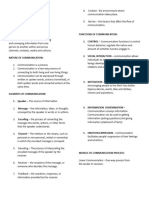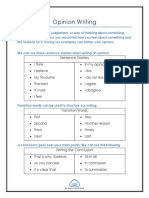OralCom Reviewer
OralCom Reviewer
Uploaded by
inayeon797Copyright:
Available Formats
OralCom Reviewer
OralCom Reviewer
Uploaded by
inayeon797Copyright
Available Formats
Share this document
Did you find this document useful?
Is this content inappropriate?
Copyright:
Available Formats
OralCom Reviewer
OralCom Reviewer
Uploaded by
inayeon797Copyright:
Available Formats
Communication - is a process of sharing and conveying messages or information from one person to
another within and another channel, concept, media, and cultures. (Mc Cornack, 2014).
Natures of Communication
1) Communication is a process
2) Communication occurs between two or more people (the speaker and the receiver)
3) Communication can be expressed through written or spoken words, actions (non-verbal, or both
spoken words and non-verbal actions at the same time.
Elements of Communication
1. Speaker – source of the information or message.
2. Message - The information, ideas, or thoughts, conveyed by the speaker.
3. Encoding - process of converting the message.
4. Channel - The medium or the means.
5. Decoding - process of interpreting the encoded message.
6. Receiver - The recipient of the message.
7. Feedback - The reactions, responses or information.
8. Context - The environment where communication takes place.
9. Barrier - affect the flow of communication.
Process of Communication
i. The speaker generates an idea
ii. The speaker encodes an idea or converts the idea into words or action
iii. The speaker transmits or sends or out a message
iv. The receiver gets the message
v. The receiver decodes or interprets the message based on the context
vi. The receiver sends or provides feedback
Models of Communication
1. Aristotle’s Model of Communication (one-way)
(Message) → (Listener)
Speaker → Speech → Audience
Most important is the setting!!!
2. Shannon-Weaver Model of Communication (one-way)
Information Source → Transmitter → Channel → Receiver → Destination
(Message) (Signal) ↑ (Received Signal) (Message)
(Noise Source)
Most Important is the Noise!!!
3. Transaction Model of Communication (two-way)
Sends Noise Noise Sends
Responds Feedback Feedback Responds
And ------------- ←→ Message ←→ ------------ And
Decodes Channel Channel Decodes
Receive Noise Noise Receive
The receiver can also be the sender and the sender can also be the receiver!!!
4. Schramm Model of Communication (two-way)
Field of experience Field of experience - Father of Mass Communication!!!
Sender Encoder → Signal → Decoder Receiver - Communication won’t last!!!
↑ ↑ ↓
← (Noise Feedback) ←
5. Eugene White Model of Communication (two-way)
Thinking Transmitting Feedback
Symbolizing Receiving Monitoring
Expressing Decoding
7 C’s of effective communication Barriers to communication
Completeness 1. Emotional barrier
Conciseness 2. Use of jargons
Consideration 3. Lack of confidence
Concreteness 4. Noisy environment
Courtesy
Clearness
Correctness
Verbal and Non-verbal Communication
Verbal communication - Refers to an interaction in which words are used to relay a message.
1) Appropriateness – The language you use should be appropriate to the environment.
2) Brevity – Use simple yet precise and powerful words to be more credible.
3) Clarity - Clearly state the message and express your ideas and feelings.
4) Ethics - Words should be carefully chosen in consideration of the gender, roles,
ethnicity, preference, and status of the person or people you are talking to.
5) Vividness - Charm your audience through the use of vivid words.
Non-verbal communication - Refers to an interaction where behavior is used to convey and represent
meanings.
Functions of Communication - Refers to how people use language in different purposes.
Five functions of communication
1. Control - To control the behavior.
2. Social interaction - Allows the individual to interact with others.
3. Motivation – Motivates or encourages to live better.
4. Emotional expression - Facilitates with people’s expression or their feelings
5. Information dissemination - To convey information.
Definition of Intercultural Communication - Refers to the effective communication between people,
worker, client of different cultural background it also includes non-verbal communication.
4 Types of Intercultural Skills
1. Personal character like communication ability is not limited to the recipient, situation, and
time.
2. Communication skills suitable to situation independent of the receiver or receivers.
3. Communication based on the audience single or many receivers.
4. Communication with a receiver about a specific topic while being constrained by time.
Purpose of Intercultural Communication
1. Sharing information or thoughts, ideas is necessary.
2. We make others aware of our presence and participate in any society.
3. Thus, avoiding separations from society fulfilling he/she achieve or aim.
You might also like
- Career Paths - Campaigner (ENFP) Personality - 16personalitiesDocument1 pageCareer Paths - Campaigner (ENFP) Personality - 16personalitiesJosé Quiroz OlmosNo ratings yet
- Basic Communication WorksheetDocument4 pagesBasic Communication Worksheetchelsea albarece100% (2)
- CathedralDocument2 pagesCathedralZ DNo ratings yet
- ORAL COMMUNICATION 1st SEM NOTESDocument3 pagesORAL COMMUNICATION 1st SEM NOTESRian mark RegaladoNo ratings yet
- The Nature of Oral CommunicationDocument40 pagesThe Nature of Oral CommunicationKate Evangelista100% (2)
- Purposive CommunicationsDocument2 pagesPurposive Communicationsviannametharam30No ratings yet
- Oc ReviewerDocument3 pagesOc ReviewerRia RegaspiNo ratings yet
- Oral Com Assignment1 Self-AuditDocument15 pagesOral Com Assignment1 Self-AuditKim YeontanNo ratings yet
- Purposive CommunicationDocument2 pagesPurposive Communicationchristian abrenicaNo ratings yet
- Oralcomm ReviewerDocument4 pagesOralcomm Reviewer예쁜SaichiNo ratings yet
- Core Subject Schedule: Mondays & Wednesdays at 10am-11am 1 Semester Academic Year 2021-2022Document26 pagesCore Subject Schedule: Mondays & Wednesdays at 10am-11am 1 Semester Academic Year 2021-2022Ruschelle LaoNo ratings yet
- Lesson 1 - Function, Nature, Process of CommunicationDocument5 pagesLesson 1 - Function, Nature, Process of CommunicationRowela Mariel MorongNo ratings yet
- Nature of CommunicationDocument26 pagesNature of CommunicationPinky SantosNo ratings yet
- Communication Communication Models: The Process of CommunicationDocument7 pagesCommunication Communication Models: The Process of CommunicationlalaNo ratings yet
- Unit 1-Nature and Elements of CommunicationDocument5 pagesUnit 1-Nature and Elements of CommunicationMa.robelleF. PapaNo ratings yet
- Oral Communication in Context First Quarter (Pointers) : 1. Schemata-DrivenDocument13 pagesOral Communication in Context First Quarter (Pointers) : 1. Schemata-DrivenMichael Jan BajenNo ratings yet
- PurCom FINALS Reviewer 2Document74 pagesPurCom FINALS Reviewer 2Renalyn Ps MewagNo ratings yet
- Eng 111 Oral Com NotesDocument3 pagesEng 111 Oral Com NotesGabriel John T. GonoraNo ratings yet
- OC Unit 1 Lesson 1.1Document14 pagesOC Unit 1 Lesson 1.1Rofelyn Joyce PampiloNo ratings yet
- The Nature of Oral CommunicationDocument40 pagesThe Nature of Oral CommunicationKate EvangelistaNo ratings yet
- Nature and Elements of CommunicationDocument17 pagesNature and Elements of CommunicationannahkaupaNo ratings yet
- Purposive Communication ReviewerDocument4 pagesPurposive Communication ReviewerMarmoleño SamanthaNo ratings yet
- 1.nature and Elements of CommunicationDocument63 pages1.nature and Elements of Communicationchayannepaco01No ratings yet
- Purposive Communication ReviewerDocument8 pagesPurposive Communication ReviewerLuis Norbert SantiagoNo ratings yet
- Oral CommunicationDocument4 pagesOral CommunicationJuliene Ermie Parel BerameNo ratings yet
- Lesson 1 - Fundamentals of CommunicationDocument37 pagesLesson 1 - Fundamentals of CommunicationDanica SantosNo ratings yet
- Hand Out For Midterm Exam in Oral CommDocument4 pagesHand Out For Midterm Exam in Oral CommRoland John MarzanNo ratings yet
- Communication: Anil VermaDocument15 pagesCommunication: Anil Vermaaniket yadav0006No ratings yet
- Chapter 2 Elements of The Communication ProcessDocument8 pagesChapter 2 Elements of The Communication Processdidimosdore16No ratings yet
- Chapter 8_ CommunicationDocument32 pagesChapter 8_ CommunicationSyed harif Syed harifNo ratings yet
- ORAL-COM-REVIEWER-FIRST-QUARTERDocument4 pagesORAL-COM-REVIEWER-FIRST-QUARTERRoland Andrei HechanovaNo ratings yet
- Oralcomq1 ReviewerDocument6 pagesOralcomq1 Reviewerzheafrances8177No ratings yet
- Pspeak Module 1Document2 pagesPspeak Module 1kikoNo ratings yet
- Understanding The SelfDocument8 pagesUnderstanding The SelfjulsabrimubinNo ratings yet
- SCRAPBOOKDocument4 pagesSCRAPBOOKRachel Curato100% (1)
- Oral Com Week 1aDocument21 pagesOral Com Week 1aAlkin RaymundoNo ratings yet
- People.: COMMUNICATION-is The Exchange of Thoughts, Feelings, Expressions, and Observations AmongDocument4 pagesPeople.: COMMUNICATION-is The Exchange of Thoughts, Feelings, Expressions, and Observations AmongJasper TrinidadNo ratings yet
- Gned 05 Lesson 1 CommunicationDocument42 pagesGned 05 Lesson 1 CommunicationbandibaciodanileNo ratings yet
- Purposive Communication LectureDocument18 pagesPurposive Communication LectureRandolf MartinezNo ratings yet
- Multicom Reviewer1Document8 pagesMulticom Reviewer1estremosevangeline1982No ratings yet
- Purcomm ReviewerDocument7 pagesPurcomm ReviewerkiaNo ratings yet
- Purcom ReviewerDocument2 pagesPurcom Reviewergimboongaling489No ratings yet
- Oral CommunicationDocument5 pagesOral CommunicationGenova ElnoritaNo ratings yet
- Oral ComDocument5 pagesOral ComHanna BantinanNo ratings yet
- Compilation of Activity in EC05Document16 pagesCompilation of Activity in EC05Jiann CapiralNo ratings yet
- Oral Communication in Context: Christine Joy Blabagno - GalinganDocument20 pagesOral Communication in Context: Christine Joy Blabagno - GalinganARIEL JOHN LUMINARIASNo ratings yet
- Bas 301Document107 pagesBas 301sharmaankit30123No ratings yet
- Activity 1 Instruction: List Down Your Daily and Routines From Morning To Evening Where You Talk orDocument8 pagesActivity 1 Instruction: List Down Your Daily and Routines From Morning To Evening Where You Talk orKim YeontanNo ratings yet
- Oral Communication ReviewerDocument2 pagesOral Communication Reviewerralpharchie01100% (1)
- GED 1 Purposive CommunicationDocument3 pagesGED 1 Purposive CommunicationPauyen L.No ratings yet
- Oral CommunicationDocument40 pagesOral CommunicationKinect Nueva EcijaNo ratings yet
- S2 OralCom ReviewerDocument11 pagesS2 OralCom ReviewerArabella MejoradaNo ratings yet
- Oral ComDocument5 pagesOral ComMhariane MabborangNo ratings yet
- ReviewerDocument7 pagesReviewerDesiree QuinioNo ratings yet
- Purpcomm Reviewer - Prelims To FinalsDocument12 pagesPurpcomm Reviewer - Prelims To Finalsjoytotheworld.zipNo ratings yet
- Oral CommunicationDocument3 pagesOral CommunicationScythe RyuNo ratings yet
- Oral Communication 1Document13 pagesOral Communication 1Kurt Russel GaleraNo ratings yet
- Oral Com - Lesson 1 Nature and Process of CommunicationDocument21 pagesOral Com - Lesson 1 Nature and Process of CommunicationElsie LofamiaNo ratings yet
- 1a PPT Communication Processes Principles Elements and FunctionsDocument54 pages1a PPT Communication Processes Principles Elements and FunctionsLheirene Mae GozonNo ratings yet
- PC RevieweeeerDocument4 pagesPC RevieweeeernidasNo ratings yet
- Communication PrinciplesDocument4 pagesCommunication PrinciplesA CNo ratings yet
- The Nonverbal Factor: Exploring the Other Side of CommunicationFrom EverandThe Nonverbal Factor: Exploring the Other Side of CommunicationNo ratings yet
- Presentation in English For Academic and Professional PurposesDocument5 pagesPresentation in English For Academic and Professional Purposesinayeon797No ratings yet
- On A Diet AND Peace Not WarDocument6 pagesOn A Diet AND Peace Not Warinayeon797No ratings yet
- Once Upon A TimeDocument7 pagesOnce Upon A Timeinayeon797No ratings yet
- Chapter 1 EvanDocument5 pagesChapter 1 Evaninayeon797No ratings yet
- PPG BillDocument2 pagesPPG Billinayeon797No ratings yet
- PPG Reviewer QBDocument13 pagesPPG Reviewer QBinayeon797No ratings yet
- PPG NotesDocument9 pagesPPG Notesinayeon797No ratings yet
- PP Students' DayDocument3 pagesPP Students' Dayinayeon797No ratings yet
- Cheese Sticks and Kutsinta 2Document7 pagesCheese Sticks and Kutsinta 2inayeon797No ratings yet
- Introduction and BackgroundDocument4 pagesIntroduction and Backgroundinayeon797No ratings yet
- New Challenges To Human AdaptationDocument2 pagesNew Challenges To Human Adaptationinayeon797No ratings yet
- GenMath ReviewerDocument3 pagesGenMath Reviewerinayeon797No ratings yet
- TABLE OF CONTENT Sa CADocument3 pagesTABLE OF CONTENT Sa CAinayeon797No ratings yet
- Write A Critical Appreciation of The Poem Tonight I Can WriteDocument2 pagesWrite A Critical Appreciation of The Poem Tonight I Can Writeinformaluse470% (1)
- Black Cat, PerversenessDocument8 pagesBlack Cat, PerversenessGNo ratings yet
- Stress and Mental HealthDocument35 pagesStress and Mental HealthCrislyn Tabiolo CercadoNo ratings yet
- The Formation Mechanism of Impulse Buying in Short Video Scenario: Perspectives From Presence and Customer InspirationDocument19 pagesThe Formation Mechanism of Impulse Buying in Short Video Scenario: Perspectives From Presence and Customer InspirationNunung lfiahNo ratings yet
- LECTURE News Writing 1Document8 pagesLECTURE News Writing 1Risha Berne EspeletaNo ratings yet
- Culture and HealthDocument14 pagesCulture and HealthNelson AmaraNo ratings yet
- Hakomi - Organization of Experience Part 3Document5 pagesHakomi - Organization of Experience Part 3Paul HubbardNo ratings yet
- Opinion WritingDocument4 pagesOpinion WritingMohamad NadaNo ratings yet
- FS2 LE5 Last Name First Name MIDocument20 pagesFS2 LE5 Last Name First Name MIAngelika Balidoy TatelNo ratings yet
- Productive Mind Mastery - Workshop ManualDocument7 pagesProductive Mind Mastery - Workshop ManualjayaswamysNo ratings yet
- Toward Anthropology of Affect and Evocative EthnographyDocument18 pagesToward Anthropology of Affect and Evocative EthnographyMaritza HCNo ratings yet
- mgt502 Final Term 21Document15 pagesmgt502 Final Term 21amirraees52No ratings yet
- Ece 251 Lesson PlanDocument3 pagesEce 251 Lesson Planapi-445611150No ratings yet
- Patients Discharged From Medium Secure Forensic Psychiatry Services: Reconvictions and Risk FactorsDocument9 pagesPatients Discharged From Medium Secure Forensic Psychiatry Services: Reconvictions and Risk FactorsIrisha AnandNo ratings yet
- Introduction To Cognitive Linguistics 1 Truong Van Anh Sai Gon UniversityDocument51 pagesIntroduction To Cognitive Linguistics 1 Truong Van Anh Sai Gon UniversityCognitive LinguisticsNo ratings yet
- Scope and Delimitations of The StudyDocument8 pagesScope and Delimitations of The StudySherwin Jay BentazarNo ratings yet
- First Occupant of The Thelma Shobe Cook Endowed Chair in Ethics andDocument2 pagesFirst Occupant of The Thelma Shobe Cook Endowed Chair in Ethics andbrylleNo ratings yet
- Detailed Lesson Plan in Art IIIDocument4 pagesDetailed Lesson Plan in Art IIILeslyn Bangibang DiazNo ratings yet
- CATS-Brochure 110116Document5 pagesCATS-Brochure 110116Asmaa El-emairyNo ratings yet
- Lesson Plan 1 - Food ChainDocument3 pagesLesson Plan 1 - Food Chainapi-327910574No ratings yet
- Contract Project PDFDocument2 pagesContract Project PDFJamalNo ratings yet
- Mental Health Nursing December 2022 January 2023Document24 pagesMental Health Nursing December 2022 January 2023Damian MunguiaNo ratings yet
- Chomskys Nativism A Critical ReviewDocument13 pagesChomskys Nativism A Critical ReviewAnas RafiNo ratings yet
- Philosophy of Education PaperDocument5 pagesPhilosophy of Education Paperapi-308501431No ratings yet
- (FREE PDF Sample) Developmental Psychology, 2e (UK Higher Education Psychology Psychology) 2nd Edition Patrick Leman EbooksDocument34 pages(FREE PDF Sample) Developmental Psychology, 2e (UK Higher Education Psychology Psychology) 2nd Edition Patrick Leman Ebookssagayapinsky100% (1)
- Research MethodsDocument58 pagesResearch MethodsAnamikaNo ratings yet
- Tle-Ia 6 - Q3 - W3 DLLDocument4 pagesTle-Ia 6 - Q3 - W3 DLLLV BENDANANo ratings yet
- Brain Book ProjectDocument2 pagesBrain Book Projectapi-338500937No ratings yet






































































































